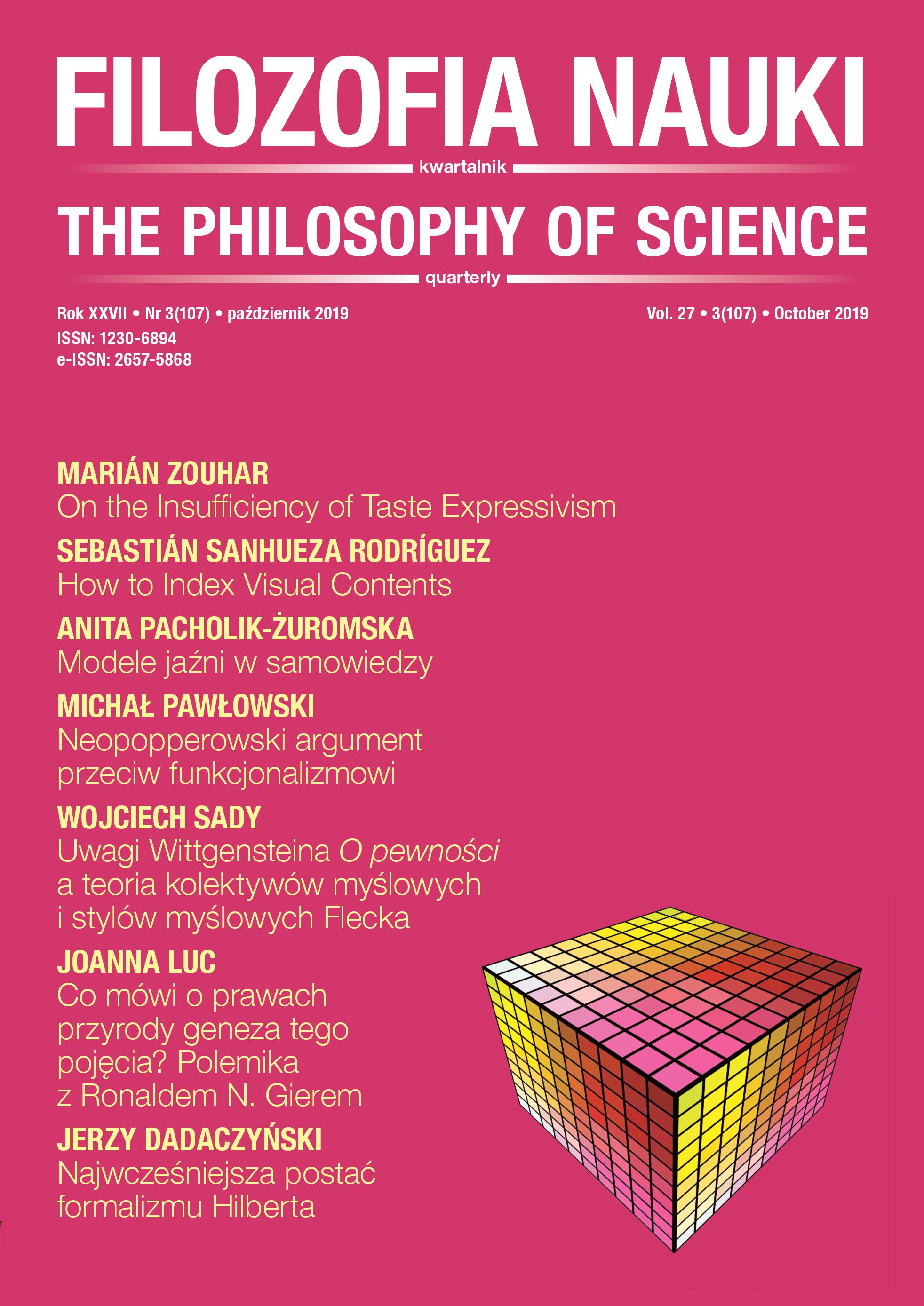How to Index Visual Contents
DOI:
https://doi.org/10.14394/filnau.2019.0016Słowa kluczowe:
Charles Travis, doświadczenie percepcyjne, reprezentacjonalizm, treść, wyglądy, demonstratywyAbstrakt
According to the Content View (CV), visual perceptual experiences represent the subject’s surroundings or have representational content. A critical question posed by Charles Travis against CV is how the subject of experiences could index or introspectively ascribe a specific representational content of a given (occurring) visual experience: if her visual experiences incorporate representational contents, how could she ascribe a particular content to any given visual experience of hers? According to Travis, while visual representation is supposed to be “a familiar phenomenon; something we can tell is happening” (Travis 2004: 86), there is no good available evidence that our visual experiences represent our surroundings; and he thinks so because there seems to be no method of visual contents’ indexation or self-ascription. The aim of this paper is to show how CV could meet what I shall call the Indexing Problem for perceptual — more specifically, visual — content. My main positive suggestion turns on the thought that the contents of visual experiences could be indexed by the way things demonstrably look to the subject of experiences.
Bibliografia
Breckenridge W. (2007a), The Meaning of ‘Look’, dissertation, New College, University of Oxford, https://bit.ly/2ARaEBX.
Breckenridge W. (2007b), “Against One Reason for Thinking That Visual Experiences Have Representational Content,” Philosophical Perspectives 21(1), 117-123. https://doi.org/10.1111/j.1520-8583.2007.00122.x
Brewer B. (1999), Perception and Reason, Oxford: Clarendon Press. https://doi.org/10.1093/0199250456.001.0001
Brewer B. (2006), “Perception and Content,” European Journal of Philosophy 14(2), 165-181. https://doi.org/10.1111/j.1468-0378.2006.00220.x
Brewer B. (2017), “The Object View of Perception,” Topoi 36(2), 215-227. https://doi.org/10.1007/s11245-015-9310-y
Brogaard B. (2014), “The Phenomenal Use of ‘Look’ and Perceptual Representation,” Philosophy Compass 9(7), 455-468. https://doi.org/10.1111/phc3.12136
Burge T. (2005), “Disjunctivism and Perceptual Psychology,” Philosophical Topics 33(1), 1-78. https://doi.org/10.5840/philtopics20053311
Byrne A. (2009), “Experience and Content,” The Philosophical Quarterly 59(236), 429-451. https://doi.org/10.1002/9781444343915.ch4
Cavedon-Taylor D. (2015), “Kind Properties and the Metaphysics of Perception: Towards Impure Relationalism,” Pacific Philosophical Quarterly 96(4), 487-509. https://doi.org/10.1111/papq.12112
Genone J. (2014), “Appearance and Illusion,” Mind 123(490), 339-376. https://doi.org/10.1093/mind/fzu056
Chisholm R. M. (1957), Perceiving: A Philosophical Study, Ithaca, NY: Cornell University Press.
Glüer K. (2009), “In Defence of a Doxastic Account of Experience,” Mind & Language 24(3), 297-327. https://doi.org/10.1111/j.1468-0017.2009.01364.x
Hacker P. M. S. (1987), Appearance and Reality: A Philosophical Investigation into Perception and Perceptual Qualities, Oxford: Basil Blackwell.
Jackson F. (1977), Perception: A Representative Theory, Cambridge: Cambridge University Press.
Martin M. G. F. (2002), “The Transparency of Experience,” Mind & Language 17(4), 376-425. https://doi.org/10.1111/1468-0017.00205
Martin M. G. F. (2004), “The Limits of Self-Awareness,” Philosophical Studies 120(1-3), 37-89. http://www.jstor.org/stable/4321508
McDowell J. (1994), Mind and World, Cambridge, MA: Harvard University Press.
McGinn C. (1989), Mental Content, Oxford: Basil Blackwell.
Millar A. (2000), “The Scope of Perceptual Knowledge,” Philosophy 75(291), 73-88. https://doi.org/10.1017/s0031819100000061
Nanay B. (2015), “The Representationalism versus Relationalism Debate: Explanatory Contextualism about Perception,” European Journal of Philosophy 23(2), 321-336. https://doi.org/10.1111/ejop.12085
Peacocke C. (1983), Sense and Content, Oxford: Clarendon Press.
Raleigh T. (2015), “Phenomenology without Representation,” European Journal of Philosophy 23(4), 1209-1237. https://doi.org/10.1111/ejop.12047
Sá Pereira R. H. de, (2016), “Combining the Representational and the Relational View,” Philosophical Studies 173(12): 3255-3269. https://doi.org/10.1007/s11098-016-0662-y
Schellenberg S. (2010), “The Particularity and Phenomenology of Perceptual Experience,” Philosophical Studies 149(1), 19-48. https://doi.org/10.1007/s11098-010-9540-1
Schellenberg S. (2017), “In Defense of Perceptual Content,” Philosophical Perspectives 31(1), 409-447. https://doi.org/10.1111/phpe.12106
Schellenberg S. (2018), The Unity of Perception, Oxford: Oxford University Press. https://doi.org/10.1093/oso/9780198827702.001.0001
Searle J. (1983), Intentionality, Cambridge: Cambridge University Press.
Sellars W. (1963), “Empiricism and the Philosophy of Mind” [in:] Science, Perception, and Reality, London—New York: Routledge and Kegan Paul, Humanities Press.
Shahmoradi A. (2016), “Why Do We Need Perceptual Content?” Philosophical Psychology 29(5), 776-788. https://doi.org/10.1080/09515089.2016.1142071
Siegel S. (2006), “Which Properties Are Represented in Perception?” [in:] Perceptual Experience, T. Szabo Gendler, J. Hawthorne (eds.), 481-503. Oxford: Oxford University Press. https://doi.org/10.1093/acprof:oso/9780199289769.003.0015
Siegel S. (2010), “Do Experiences Have Contents?” [in:] Perceiving the World, B. Nanay (ed.), Oxford: Oxford University Press. https://doi.org/10.1093/acprof:oso/9780195386196.003.0012
Siegel S. (2011), The Contents of Visual Experience, Oxford: Oxford University Press. https://doi.org/10.1093/acprof:oso/9780195305296.001.0001
Snowdon P. (1992), “How to Interpret ‘Direct Perception’” [in:] The Contents of Experience, T. Crane (ed.), Cambridge: Cambridge University Press, 48-78. https://doi.org/10.1017/CBO9780511554582.004
Soteriou M. (2005), “The Subjective View of Experience and Its Objective Commitments,” Proceedings of the Aristotelian Society 105(1), 177-190. https://doi.org/10.1111/j.0066-7373.2004.00110.x
Soteriou M. (2007), “Content and the Stream of Consciousness,” Philosophical Perspectives 21(1), 543-568. https://doi.org/https://doi.org/10.1111/j.1520-8583.2007.00135.x
Soteriou M. (2013), The Mind’s Construction: The Ontology of Mind and Mental Action, Oxford: Oxford University Press. https://doi.org/http://doi.org/10.1093/acprof:oso/9780199678457.001.0001
Soteriou M. (2016), Disjunctivism, London: Routledge.
Travis C. (1997), “Pragmatics” [in:] A Companion to the Philosophy of Language, B. Hale, C. Wright (eds.), Oxford: Blackwell.
Travis C. (2004), “The Silence of the Senses,” Mind 113, 57-94. https://doi.org/10.1093/mind/113.449.57
Travis C. (2013), Perception: Essays after Frege, Oxford: Oxford University Press. https://doi.org/http://doi.org/10.1093/acprof:oso/9780199676545.001.0001



















 Filozofia Nauki | ISSN 1230-6894 | e-ISSN 2657-5868
Filozofia Nauki | ISSN 1230-6894 | e-ISSN 2657-5868